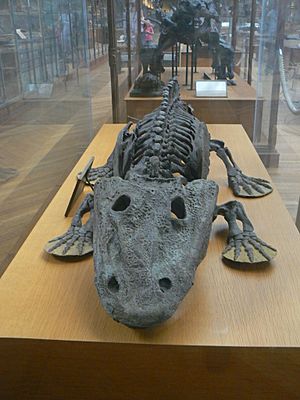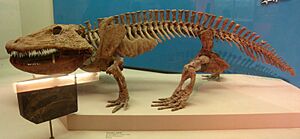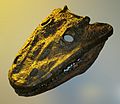Eryops facts for kids
Quick facts for kids Eryops |
|
|---|---|
 |
|
| Eryops: National Museum of Natural History, Washington DC | |
| Scientific classification | |
| Genus: |
Eryops
|
| Species: |
megacephalus
|
Eryops was an amazing animal that lived a very long time ago. It was a type of amphibian called a temnospondyl, which means it could live both on land and in water. Imagine a giant salamander! Eryops is now extinct, meaning it no longer exists on Earth.
Contents
What Was Eryops?
Eryops was a genus of extinct, semi-aquatic temnospondyl. This means it was an ancient amphibian that spent time both in water and on land. It was one of the largest land animals of its time.
When and Where Did Eryops Live?
These ancient creatures mostly lived during the Permian period, about 295 million years ago. That's even before the dinosaurs! Their fossils are often found in places like Texas, New Mexico, and other parts of the eastern United States. These areas were once covered in "red beds," which are special rocks that show where ancient rivers and lakes used to be. Eryops also lived earlier, during the Pennsylvanian period, in places like West Virginia.
How Big Was Eryops?
Eryops was quite large for its time. It grew to be about 1.5 to 2 meters (5 to 6.5 feet) long. That's longer than most grown-ups are tall! It weighed around 90 kilograms (200 pounds), which is like a small bear.
What Did Eryops Look Like?
Eryops had a big, flat skull and strong jaws with many sharp teeth. Its body was sturdy, supported by strong limbs. These limbs and a powerful spine helped it move around on land. It was much better at walking on land than its ancestors.
Who Were Its Neighbors?
Eryops probably didn't have many predators because of its size. However, the top predator of that time was a creature called Dimetrodon. Dimetrodon was even bigger than Eryops and was a type of animal called a synapsid, which are ancestors of mammals.
What Fossils Do We Find?
Scientists have found several complete skeletons of Eryops. But the most common fossils are its skull bones and teeth. These fossils help us learn how Eryops lived and what its world was like.
Images for kids
See also
 In Spanish: Eryops para niños
In Spanish: Eryops para niños




